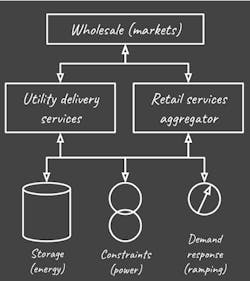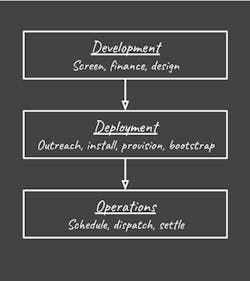The Energy Transition: Transition, Transformation and Transactive Energy
Over the course of the Spring and Summer this year, I’ve enjoyed discussions with two energy experts about their vision of transactive energy, their software program TESS — short for Transactive Energy Service System — and the implications of such a platform to dramatically scale DER and enable critical transportation and building electrification and grid modernization.
The Innovators
Three PhDs - a climate scientist, an energy economist and a power engineer — walk into a bar …
No short joke with a punchline, the story that follows is compelling, complex and groundbreaking. What we describe herein is an incredible collaboration of great minds that holds potential to solve one of the most vexing challenges in the electricity sector — how to rapidly democratize the grid and introduce digitalization and data to welcome DER at scale into our complex, modernizing grid paradigm.
David Chassin, PhD is an engineer by training, now serving as Manager and Chief Scientist of GISMo — Grid Integration, Systems and Mobility — a multi-disciplinary research group that’s part of the Applied Program in the SLAC National Accelerator Laboratory at Stanford, one of the 17 National Energy Labs under DOE. Prior, Dr. Chassin had a long career as staff scientist at Pacific Northwest National Laboratory (PNNL), where he published over 150 articles, white papers, etc. David is the lead scientist on the TESS project.
Lynne Kiesling, PhD. Dr. Kiesling, a collaborator on the TESS project, is an economist with deep experience in regulation, market design and digitization and smart grid technologies in the electricity industry. She recently accepted a position as Research Professor & Co-Director, Institute for Regulatory Law & Economics IRLE at the University of Colorado Denver. Previously, Dr. Kiesling served as a Faculty Affiliate in the Wilton E. Scott Institute for Energy Innovation, at Carnegie Mellon University.
Bryan Hannegan, PhD is a climate scientist, innovator and thought leader, currently President and CEO at Holy Cross Energy, an electric cooperative in the Rockies. Prior, he served as Associate Lab Director at DOE’s National Renewable Energy Lab (NREL), where he co-founded DOE’s Grid Modernization Initiative (GMI). He also launched the Energy Systems Integration Facility (ESIF) at NREL that enables distribution grid experimentation.
Holy Cross Energy, Continued
I was fortunate to interview all three of these innovators for this two-part story. In Part 1, I focused on my interview with Bryan Hannegan and his work in Colorado. We examined the unique project underway outside Aspen, in the service territory of Holy Cross. Here in part two, I’ll focus on the two innovators helping to redefine the concept of Transactive Energy. I’ll let my interviews with David Chassin and Lynne Kiesling continue the story as we explore how bringing market concepts into the utility sector holds the promise of transformation.
In 2019, Lynne and David found themselves invited into the project at Holy Cross, which they saw as a great opportunity to explore practical ways to scale grid integrated DER. The four homes in the original project we described in the last article will ultimately scale up to 27, including low-income Habitat for Humanity homes equipped with advanced technologies, supporting environmental and social justice objectives.
So, what is TESS anyway?
Understanding TESS, the Transactive Energy Service System Platform
I first asked David and Lynne how they came to collaborate on transactive energy. David told me that the TESS project he’s running at his GISMO Lab at Stanford inside SLAC is creating a new software platform that will transform how utilities relate to DER. TESS is a response to a challenge that emerged from his early work on transactive control, where he met Lynne. Lynne shared with me that she met David in 2003, back when he was really engaged in the mathematical and scientific aspects of buildings and systems engineering at Pacific Northwest National Lab (PNNL).
Lynne. We had a grander vision that found its way 15 years ago or so into the Olympic Peninsula Project based on a general idea to build a transactive system, but back then it was very much an engineering project. For my part, I worked with other collaborators on a conceptual economics framework for getting to a transactive system with price-based dispatch automation. Since David got his PhD and moved to SLAC, he’s become a fantastic intellectual leader in developing our vision of a flexible, adaptable clean energy future based on markets and prices. The addition of Bryan Hannegan — a climate scientist positioned inside a utility with entrepreneurial ideas and vision — has allowed us to put a stake in the ground to become 100% carbon free by 2030 and challenged us all to get there in a cost effective and equitable manner.
John: Where did TESS come from?
David: Early demonstrations of transactive control focused on integrating multiple distributed energy resources (DER) onto the grid using a retail market mechanism. The idea of transactive control is to allow DER to respond to price variations that reflect local conditions, not just the wholesale conditions, which are already reflected in the price. Rather, the short-term fluctuations in constraints and availability of local resources must also be reflected.Lynne: At its core, economics is the foundational principle that distinguishes transactive energy from other platforms. From the economist perspective if you want to invent the economics for the system, your bidding functions should communicate something about the users’ willingness preferences and that's different from the device cost. We're starting field trials in Colorado with solar PV and PV building functions, so expanding the scope will mean bringing in new capabilities associated with EV charging and battery integration in future field trials. We already have the thermostatic loads capability from our work in the Olympic Peninsula project more than a decade ago. From an economics perspective, our challenge is to write the bidding functions for each of those device types in ways that communicate user preferences, not just the underlying cost or engineering characteristics of the device.
David: Early transactive concepts were more oriented on price response, where parties would provide a price to devices and devices would respond. In contrast, with TESS we work on providing prices from devices that tell us their willingness to pay. Understanding their willingness to produce allows us to discover the right local market price, where a bidirectional flow of information lets us optimize the mix of resources with a market mechanism. It’s important to think of these transactions in terms of services rather than as a commodity product (e.g., electricity). The key to a full-fledged transactive system is the ability to coordinate three dimensions to derive the most economic and comfortable outcome. Every DER has the potential to provide different service dimensions (as shown in the inset). Having all three dimensions available provides full control over the system, in much the same way that PID control is deployed in other industrial processes.
New transactive energy systems will be able to integrate these three prices, providing all the degrees of freedom needed to manage any system's response to changing conditions. From this perspective, older transactive energy pricing used a single energy price that we could describe as “underactuated,” providing only one dimension, when having all three prices is key. Our first project with Holy Cross was based on one dimension, our next project will introduce the second dimension of storage, and a subsequent project will feature ramping.
Lynne: People have become comfortable with pricing that they weren't familiar with back in the 80s. Consumers now encounter a wide range of different pricing types daily based on how much of our commerce has become digital and involves digital platforms. So today we can have an economical bidding function as well as an environmental bidding function or we can have more of a blend to create three options. In behavioral economics we call it choice architecture, which is quite different from pricing in the utility industry with its history of vertical integration and regulation, where energy consumers have become habituated to view electricity as a commodity product.
When the regulatory environment has been structured to treat electricity as a plain vanilla product - to homogenize it and determine the least cost way to provide it to the greatest number of people, success since the 1960s has locked in a popular definition of electricity pricing. But outside the electricity sector, pricing has matured in different ways. Digitization has reduced transaction costs to give consumers greater choice, driving both value creation and profitability. The updated vision of transactive energy then is that it's not just really a fundamental physical level, rather it’s about coordination, resilience, flexibility, and increasingly, it's about empowering individuals to make their own energy choices if they so choose. So, we’re thinking in terms of variety bidding functions for the devices to give consumers opportunities to consume and produce now; the prosumer revolution means consumers produce energy as they want, and automation makes it cheaper and easier for them to do that by defining parameters or choosing retailers that provide the parameters they like.
The mass customization of energy is on the horizon - no one's tried it yet; it’s still a novel concept. We need DER at scale, affordable energy storage, and digitalization to make networking, automation and a market layer possible. I want to stress that markets are platforms for relationships and social cooperation. Even when engaged in transactions with strangers, we're still in a relationship around a shared value. And customization around social cooperation is another important concept, where markets are platforms, and we use information embedded in price signals to coordinate our actions and plans. Our approach to transactive energy is that we’re paying attention to the physical behavior of physical system elements as constraints…everything that we want to do economically has to abide by the physical characteristics of the devices in the system.
John: So you're really crafting economic algorithms around a highly constrained complex system?
Lynne: YES! When we think about the Internet, we interconnected emergent complex systems, so the Internet can be our poster child of a system of systems because of its layered architecture. As it becomes more digital, the electric system architecture moves in a similar layer direction. Systems thinking in terms of interaction and interconnection to identify dependencies allows us to conceive of a modular system design. TESS must abide by physical constraints but also embed economics at a deep level to be able to include customer preferences in a price discovery process. As a technological system it becomes interoperable — more like Open Access that we sometimes see in broadband.
John: Any last words on how to make the distribution grid better able to integrate markets and price-based dispatch systems using responsiveness, flexibility and adaptability?
David: In terms of physical design, having all three pricing dimensions provides far superior system control and greater flexibility and options. With PID, TESS becomes a versatile platform that not only solves the technical problem of transactive energy in a world where the marginal energy price of DER is falling, but also introduces new business aspects heretofore unattainable. Ideally for utilities, the complete lifecycle toolkit provided by TESS would allow initial project screening (situation, utility needs & constraints, location and customer), while resolving some financing and engineering challenges as well.
On project launch, TESS can also be used to guide modification of infrastructure, back-office systems, wholesale market procurement, staffing adjustments, retooling, etc. These resources, purchased from the wholesale market, can help utilities to comply with FERC 2222, allowing the utility to act as the aggregator and not have to rely on a third-party aggregator. Given all these changes, the control room dispatch operations will need to adapt to understand what DER will be capable of doing and how price signals will influence accessing those resources. With control room training and access to TESS, a new settlement process should emerge to integrate all the new resources.
Lynne. With digitalization, we get AI, which is inherently about massive creative destruction that will force a reallocation of labor, much like 110 years ago. Back then low-skilled labor worked to make buggies and horse whips but quickly transitioned into the low-skilled labor force working in automobile factories to make Model-Ts. I think as digitalization progresses, we’ll see AI change the nature of low-skilled work into something like updating code modules. Where systems engineers, regulators and lawyers have historically focused on control of a physical system, digitalization will lead us to consider more deeply how cyber-physical systems work.
The purpose of these systems is to create value for humans, to allow them to thrive and flourish in whatever their life projects may be. I think we will increasingly think about our electric system as a cyber-physical social system. In economics, we must always remember that to the extent that humans are rational they make the best decisions they can with the information available at any given time. But humans have other interests beyond the financial aspects, beyond the energy bill. If our legacy pricing system was unidimensional based on cost and reliability, we’re moving now into multiple dimensions that more equate to human behavior.
About the Author
John Cooper
John Cooper, Founder and CEO of NXT NRG, is an energy entrepreneur and recognized innovator in the electricity sector. Based in Austin, TX, NXT NRG provides services that integrate decarbonization with resilience, energy self-sufficiency, transportation & building electrification, and data/digitalization. John is a widely published author and public speaker (The Advanced Smart Grid: Edge Power Driving Sustainability, 2011 1st Ed, 2014 2nd Ed). John has an MBA and a BA in Government with honors from the University of Texas at Austin



